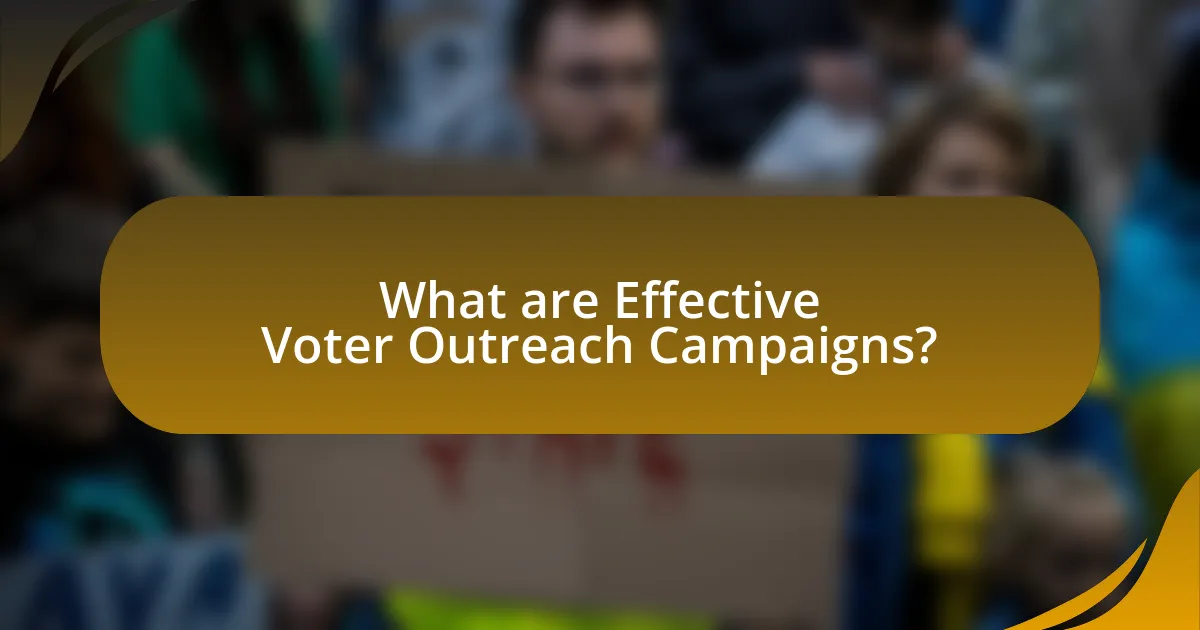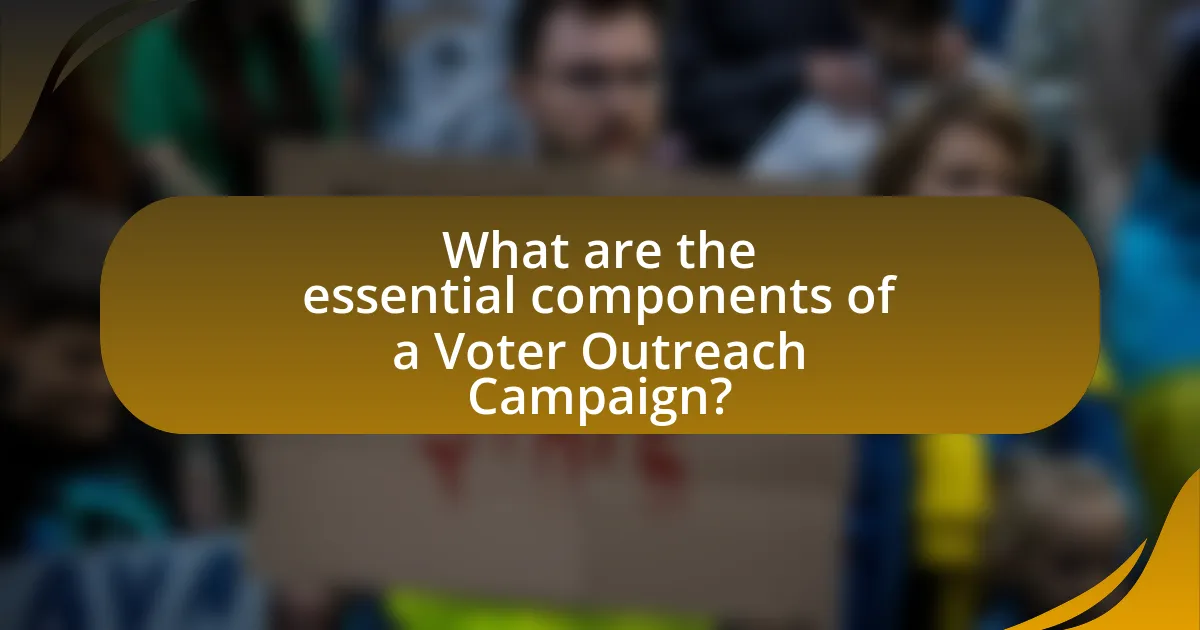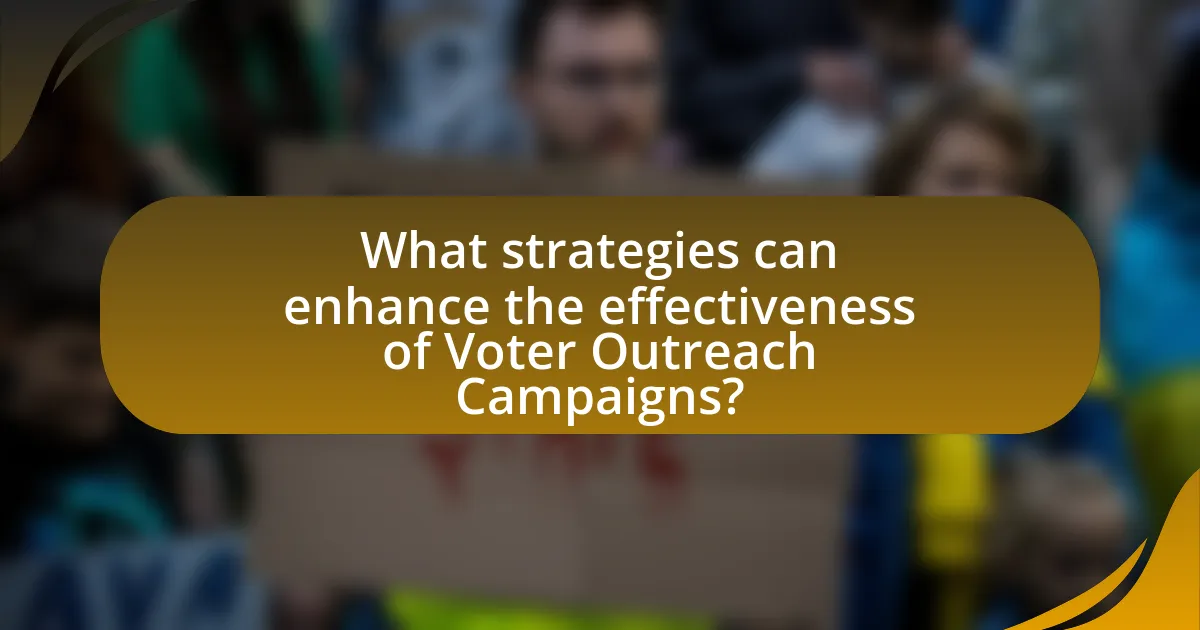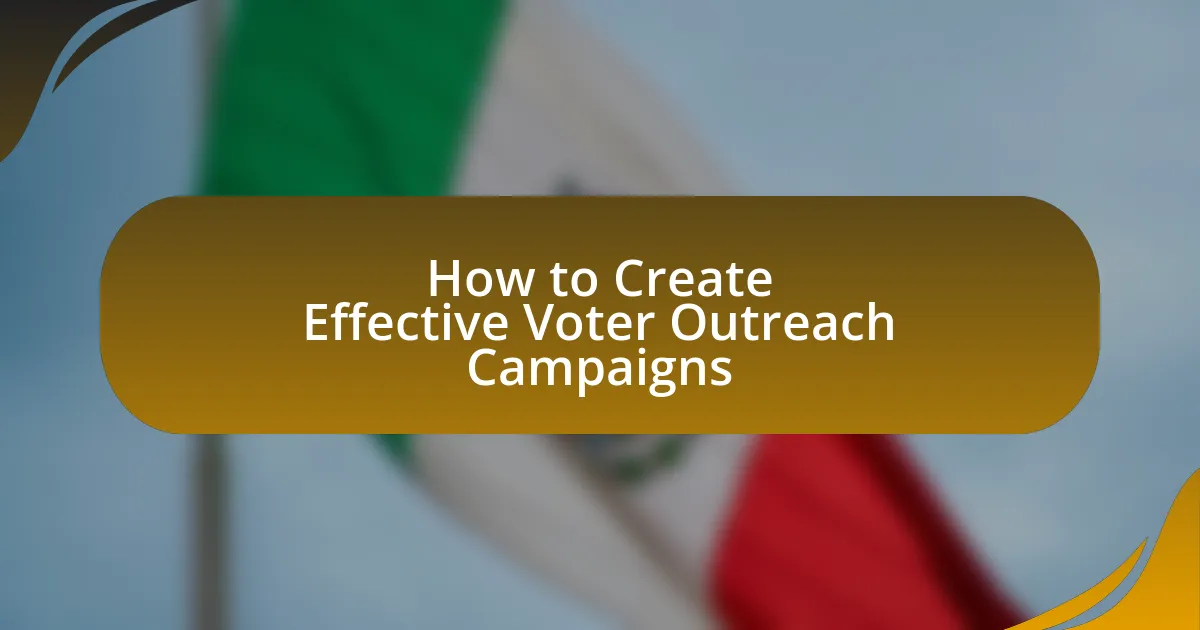Effective voter outreach campaigns are strategic initiatives aimed at engaging and mobilizing voters to enhance participation in the electoral process. The article outlines the significance of these campaigns, emphasizing their role in increasing voter registration, turnout, and education, particularly among underrepresented communities. It discusses the impact of demographics on campaign design, the importance of tailored messaging, and the effectiveness of various outreach methods, including digital and traditional media. Additionally, the article highlights best practices for measuring campaign success, addressing challenges such as misinformation and voter apathy, and ensuring inclusivity in outreach efforts.

What are Effective Voter Outreach Campaigns?
Effective voter outreach campaigns are strategic initiatives designed to engage and mobilize voters, ensuring they are informed about the electoral process and motivated to participate. These campaigns utilize various methods, including door-to-door canvassing, phone banking, social media engagement, and community events, to reach diverse demographics. Research indicates that targeted outreach efforts can significantly increase voter turnout; for instance, a study by the National Bureau of Economic Research found that door-to-door canvassing can increase turnout by 7 to 10 percentage points. By employing data-driven strategies and tailoring messages to specific communities, effective voter outreach campaigns enhance civic participation and strengthen democratic processes.
How do Voter Outreach Campaigns influence electoral participation?
Voter outreach campaigns significantly increase electoral participation by actively engaging and informing potential voters about the voting process and issues at stake. These campaigns utilize various strategies, such as door-to-door canvassing, phone banking, and social media outreach, to reach diverse demographics, thereby enhancing voter awareness and motivation. Research indicates that targeted outreach efforts can lead to a measurable increase in voter turnout; for instance, a study by the National Bureau of Economic Research found that personalized contact can increase turnout by as much as 10%. This demonstrates that effective voter outreach campaigns not only inform but also mobilize individuals to participate in elections.
What are the key objectives of Voter Outreach Campaigns?
The key objectives of Voter Outreach Campaigns are to increase voter registration, enhance voter turnout, and educate the electorate about the voting process and issues at stake. These campaigns aim to engage underrepresented communities, ensuring that diverse voices are heard in the electoral process. For instance, studies have shown that targeted outreach efforts can lead to a significant increase in voter participation, with some campaigns reporting turnout increases of up to 20% in specific demographics.
How do demographics affect the design of Voter Outreach Campaigns?
Demographics significantly influence the design of voter outreach campaigns by determining the target audience’s characteristics, preferences, and communication styles. For instance, age demographics can dictate the platforms used for outreach; younger voters may respond better to social media campaigns, while older voters might prefer traditional methods like direct mail or phone calls. Additionally, cultural and ethnic demographics shape messaging and engagement strategies, as campaigns must resonate with the values and concerns of diverse communities. Research shows that tailored messaging increases voter engagement; for example, a study by the Pew Research Center found that personalized outreach can boost turnout by as much as 10%. Thus, understanding demographics allows campaigns to effectively allocate resources and craft messages that resonate with specific voter segments.
Why is it important to engage voters?
Engaging voters is crucial because it enhances democratic participation and ensures that elected representatives reflect the will of the people. When voters are actively engaged, they are more likely to turn out on election day, which can significantly impact election outcomes. For instance, research from the U.S. Census Bureau indicates that voter turnout in the 2020 presidential election was approximately 66.8%, the highest rate since 1900, largely attributed to increased voter engagement efforts. Engaging voters also fosters informed decision-making, as it encourages individuals to learn about candidates and issues, leading to more educated choices at the polls.
What impact does voter engagement have on election outcomes?
Voter engagement significantly influences election outcomes by increasing voter turnout, which often leads to the election of candidates who align with the preferences of engaged voters. For instance, studies show that higher levels of voter engagement can boost turnout by as much as 20% in certain demographics, thereby altering the results in closely contested races. Additionally, engaged voters tend to be more informed about candidates and issues, which can lead to more thoughtful decision-making at the polls. This correlation between engagement and turnout is supported by data from the U.S. Census Bureau, which indicates that states with robust voter outreach initiatives experience higher participation rates in elections.
How can voter engagement strategies be tailored to different communities?
Voter engagement strategies can be tailored to different communities by understanding their unique demographics, cultural values, and communication preferences. For instance, strategies that resonate with younger voters may include social media campaigns and interactive platforms, while older populations might respond better to traditional methods like direct mail and community meetings. Research from the Pew Research Center indicates that 88% of younger voters use social media for political information, highlighting the importance of digital outreach in engaging this demographic. Additionally, incorporating multilingual materials can enhance outreach in diverse communities, as evidenced by the U.S. Census Bureau data showing that over 21% of U.S. residents speak a language other than English at home. By customizing approaches based on these factors, voter engagement can become more effective and inclusive.

What are the essential components of a Voter Outreach Campaign?
The essential components of a Voter Outreach Campaign include targeted messaging, community engagement, data-driven strategies, and effective communication channels. Targeted messaging ensures that the campaign resonates with specific demographics, addressing their unique concerns and interests. Community engagement involves mobilizing local leaders and organizations to foster trust and encourage participation. Data-driven strategies utilize voter data and analytics to identify key areas for outreach and measure campaign effectiveness. Effective communication channels, such as social media, email, and in-person events, facilitate direct interaction with voters, enhancing the campaign’s reach and impact. These components collectively contribute to a successful voter outreach effort, as evidenced by numerous campaigns that have effectively increased voter turnout through strategic planning and execution.
How do you identify your target audience for a Voter Outreach Campaign?
To identify your target audience for a Voter Outreach Campaign, analyze demographic data, voting history, and community interests. This involves gathering information from sources such as census data, voter registration records, and surveys to understand the characteristics of potential voters. For instance, targeting specific age groups, ethnic communities, or geographic areas can enhance outreach effectiveness, as evidenced by studies showing that tailored messaging increases voter engagement by up to 30%.
What methods can be used to research voter demographics?
Surveys and polls are primary methods used to research voter demographics. These tools gather quantitative data on voter preferences, behaviors, and characteristics, allowing researchers to analyze trends and patterns. For instance, the Pew Research Center frequently conducts surveys that provide insights into demographic factors such as age, race, and education level among voters. Additionally, analyzing census data offers a comprehensive overview of population characteristics, which can be correlated with voting behavior. This method is supported by the U.S. Census Bureau, which provides detailed demographic statistics that are crucial for understanding voter segments.
How can you segment your audience for more effective outreach?
To segment your audience for more effective outreach, identify key demographic, psychographic, and behavioral characteristics of potential voters. This approach allows for tailored messaging that resonates with specific groups, enhancing engagement and response rates. For instance, research by the Pew Research Center indicates that targeted messaging based on age, income, and political affiliation can significantly improve voter turnout, as individuals are more likely to respond to content that reflects their values and concerns. By utilizing data analytics and surveys, campaigns can effectively categorize voters, ensuring that outreach efforts are both relevant and impactful.
What channels are most effective for Voter Outreach?
Digital channels, particularly social media platforms and email, are the most effective for voter outreach. Research indicates that social media allows campaigns to engage directly with voters, facilitating real-time communication and targeted messaging. For instance, a study by the Pew Research Center found that 69% of adults in the U.S. use social media, making it a vital tool for reaching a broad audience. Additionally, email outreach has proven effective, with a report from the Data & Marketing Association showing that email marketing has an average return on investment of $42 for every dollar spent. These channels enable campaigns to mobilize supporters, disseminate information quickly, and encourage voter participation.
How can social media be leveraged in Voter Outreach Campaigns?
Social media can be leveraged in voter outreach campaigns by utilizing targeted advertising, engaging content, and community building to reach and mobilize voters effectively. Targeted advertising allows campaigns to reach specific demographics based on location, interests, and behaviors, which can increase voter engagement; for instance, Facebook’s advertising platform enables campaigns to tailor messages to particular voter segments. Engaging content, such as videos, infographics, and interactive posts, can capture attention and encourage shares, amplifying the campaign’s reach. Additionally, building a community through social media platforms fosters dialogue and connection among supporters, which can enhance voter turnout; studies show that social media interactions can significantly influence voter behavior, with 50% of young voters reporting that social media impacted their decision to vote in the 2020 election.
What role do traditional media play in reaching voters?
Traditional media play a crucial role in reaching voters by providing a platform for disseminating information about candidates, policies, and electoral processes. Television, radio, and print media have historically been primary sources of news, influencing public opinion and voter behavior. For instance, according to a Pew Research Center study, 57% of adults reported getting news from television, highlighting its significant impact on voter awareness and engagement. Additionally, traditional media can shape narratives and frame issues, which can sway undecided voters during critical election periods.

What strategies can enhance the effectiveness of Voter Outreach Campaigns?
To enhance the effectiveness of voter outreach campaigns, employing targeted messaging and utilizing data analytics are crucial strategies. Targeted messaging ensures that communication resonates with specific demographics, increasing engagement; for instance, campaigns that tailor their messages to address the unique concerns of young voters have shown higher turnout rates. Utilizing data analytics allows campaigns to identify key voter segments and optimize outreach efforts based on behavioral insights, leading to more efficient resource allocation. According to a study by the Pew Research Center, campaigns that leverage data-driven strategies can increase voter turnout by up to 15%.
How can messaging be crafted to resonate with voters?
Messaging can be crafted to resonate with voters by focusing on their values, concerns, and aspirations. Effective messaging should utilize relatable language and address specific issues that matter to the target audience, such as healthcare, education, or economic stability. Research indicates that campaigns that personalize messages and use storytelling techniques can significantly enhance voter engagement. For instance, a study by the Pew Research Center found that 70% of voters are more likely to support candidates who share personal stories that reflect their own experiences and challenges. This approach not only builds emotional connections but also fosters trust and relatability, making the messaging more impactful.
What are the best practices for creating compelling campaign messages?
The best practices for creating compelling campaign messages include understanding the target audience, crafting a clear and concise message, and utilizing emotional appeal. Understanding the target audience allows campaigners to tailor messages that resonate with specific demographics, increasing engagement. A clear and concise message ensures that the core idea is easily understood and remembered, which is crucial in a crowded media landscape. Emotional appeal, supported by research from the American Psychological Association, shows that messages that evoke emotions can significantly enhance persuasion and motivate action. By integrating these elements, campaign messages can effectively capture attention and drive voter participation.
How can storytelling be used to engage voters emotionally?
Storytelling can engage voters emotionally by creating relatable narratives that resonate with their personal experiences and values. When political campaigns utilize stories that highlight real-life challenges and triumphs, they foster empathy and connection, making abstract political issues more tangible. For instance, a campaign that shares the story of a family struggling with healthcare costs can evoke strong emotional responses, prompting voters to consider the implications of policy decisions on their lives. Research indicates that narratives can significantly influence voter attitudes and behaviors, as they activate emotional responses in the brain, making the information more memorable and impactful.
What role does community involvement play in Voter Outreach?
Community involvement is crucial in voter outreach as it fosters trust and engagement among potential voters. When community members actively participate in outreach efforts, they can effectively communicate the importance of voting and address specific local issues that resonate with their peers. Research indicates that grassroots campaigns, which leverage local networks and relationships, can increase voter turnout by as much as 10% compared to traditional methods. This is supported by a study from the Harvard Kennedy School, which found that personal connections and community-driven initiatives significantly enhance voter mobilization efforts.
How can partnerships with local organizations strengthen outreach efforts?
Partnerships with local organizations can significantly strengthen outreach efforts by leveraging their established community trust and networks. Local organizations often have deep-rooted connections with residents, which can enhance credibility and facilitate access to target populations. For instance, a study by the Pew Research Center indicates that community-based organizations are effective in mobilizing voters, as they can provide tailored information and resources that resonate with local needs. Additionally, collaborations can lead to shared resources, such as venues for events and volunteers, which can amplify outreach activities and increase participation rates in voter campaigns.
What are effective ways to mobilize volunteers for outreach activities?
Effective ways to mobilize volunteers for outreach activities include leveraging social media platforms, organizing community events, and establishing partnerships with local organizations. Social media platforms like Facebook and Twitter can reach a broad audience quickly, allowing for targeted recruitment campaigns that highlight the impact of volunteer work. Organizing community events, such as informational sessions or volunteer fairs, fosters personal connections and encourages participation by showcasing the outreach activities’ goals and benefits. Additionally, partnerships with local organizations can provide access to established networks of potential volunteers, enhancing recruitment efforts. Research indicates that community engagement strategies significantly increase volunteer participation rates, demonstrating the effectiveness of these methods in mobilizing volunteers for outreach activities.
What are common challenges faced in Voter Outreach Campaigns?
Common challenges faced in voter outreach campaigns include reaching diverse populations, overcoming misinformation, and ensuring voter engagement. Reaching diverse populations can be difficult due to language barriers, cultural differences, and varying levels of access to technology. Overcoming misinformation is critical, as false narratives can deter voters and create confusion about the voting process. Ensuring voter engagement is also a challenge, as campaigns must find effective ways to motivate individuals to participate, especially among younger voters who may feel disillusioned. These challenges are supported by studies indicating that targeted messaging and community involvement significantly enhance outreach effectiveness.
How can misinformation be addressed during outreach efforts?
Misinformation can be addressed during outreach efforts by implementing fact-checking mechanisms and providing clear, accurate information to the target audience. Outreach campaigns should incorporate real-time fact-checking resources, such as partnerships with reputable fact-checking organizations, to counter false claims immediately. For instance, the Pew Research Center found that 64% of Americans believe misinformation is a major problem, highlighting the need for proactive measures. Additionally, using multiple communication channels, including social media, community events, and direct mail, ensures that accurate information reaches diverse demographics effectively.
What strategies can be implemented to overcome voter apathy?
To overcome voter apathy, strategies such as increasing voter education, enhancing accessibility, and fostering community engagement can be implemented. Increasing voter education involves providing clear, factual information about the voting process, candidates, and issues, which can lead to informed decision-making. Research indicates that informed voters are more likely to participate in elections; for instance, a study by the Pew Research Center found that 70% of informed individuals reported voting compared to only 40% of those who felt uninformed. Enhancing accessibility includes measures like simplifying registration processes and providing resources in multiple languages, which can help remove barriers for underrepresented groups. Lastly, fostering community engagement through local events and discussions can create a sense of belonging and motivate individuals to participate in the electoral process, as evidenced by initiatives that have successfully increased turnout in various communities.
What are the best practices for measuring the success of Voter Outreach Campaigns?
The best practices for measuring the success of Voter Outreach Campaigns include setting clear objectives, utilizing data analytics, and conducting surveys. Clear objectives allow campaigns to define success metrics, such as voter turnout rates or engagement levels. Data analytics can track interactions and responses across various platforms, providing insights into which strategies are most effective. Surveys can gather direct feedback from participants, assessing their awareness and motivations related to the campaign. According to a study by the Pew Research Center, campaigns that effectively measure and analyze their outreach efforts can increase voter turnout by up to 10%.
How can you track engagement and participation rates effectively?
To track engagement and participation rates effectively, utilize analytics tools that measure interactions across various platforms. These tools, such as Google Analytics for website traffic and social media insights for engagement metrics, provide quantifiable data on user behavior and participation levels. For instance, a study by the Pew Research Center indicates that social media engagement can significantly influence voter turnout, with platforms like Facebook showing a 20% increase in participation among users who engage with political content. By analyzing these metrics, campaign managers can identify which outreach strategies resonate most with voters, allowing for data-driven adjustments to enhance overall effectiveness.
What metrics should be used to evaluate campaign effectiveness?
To evaluate campaign effectiveness, key metrics include voter turnout, engagement rates, conversion rates, and return on investment (ROI). Voter turnout measures the percentage of eligible voters who participate in the election, indicating the campaign’s ability to mobilize supporters. Engagement rates assess interactions on social media and other platforms, reflecting the campaign’s resonance with the audience. Conversion rates track how many individuals take a desired action, such as registering to vote or attending an event, showcasing the campaign’s effectiveness in persuading potential voters. ROI evaluates the financial efficiency of the campaign by comparing the costs incurred to the outcomes achieved, providing insight into the overall impact of the campaign. These metrics collectively offer a comprehensive view of a campaign’s success in reaching and influencing voters.
What practical tips can improve your Voter Outreach Campaign?
To improve your Voter Outreach Campaign, focus on targeted messaging and community engagement. Tailoring your communication to specific demographics increases relevance and resonance, as studies show that personalized outreach can boost voter turnout by up to 20%. Additionally, leveraging local events and partnerships with community organizations fosters trust and encourages participation, evidenced by successful campaigns that utilized grassroots strategies to mobilize voters effectively.
How can you ensure your outreach is inclusive and accessible?
To ensure your outreach is inclusive and accessible, implement strategies that address diverse community needs and remove barriers to participation. This includes using multiple communication channels, such as social media, community events, and printed materials in various languages and formats, ensuring that information reaches all demographics. Additionally, consider accessibility features like sign language interpreters, braille materials, and easy-to-read content to accommodate individuals with disabilities. Research indicates that inclusive outreach efforts can increase voter participation by up to 20% in underrepresented communities, highlighting the importance of tailored approaches in voter engagement.
What are the key takeaways for running a successful Voter Outreach Campaign?
The key takeaways for running a successful Voter Outreach Campaign include understanding the target audience, utilizing multiple communication channels, and engaging with the community. Understanding the target audience allows campaigners to tailor messages that resonate with specific demographics, increasing the likelihood of voter engagement. Utilizing multiple communication channels, such as social media, direct mail, and in-person events, ensures broader reach and accessibility, as studies show that campaigns using diverse methods can increase voter turnout by up to 20%. Engaging with the community through local events and partnerships fosters trust and encourages participation, as evidenced by successful campaigns that prioritize grassroots involvement.
